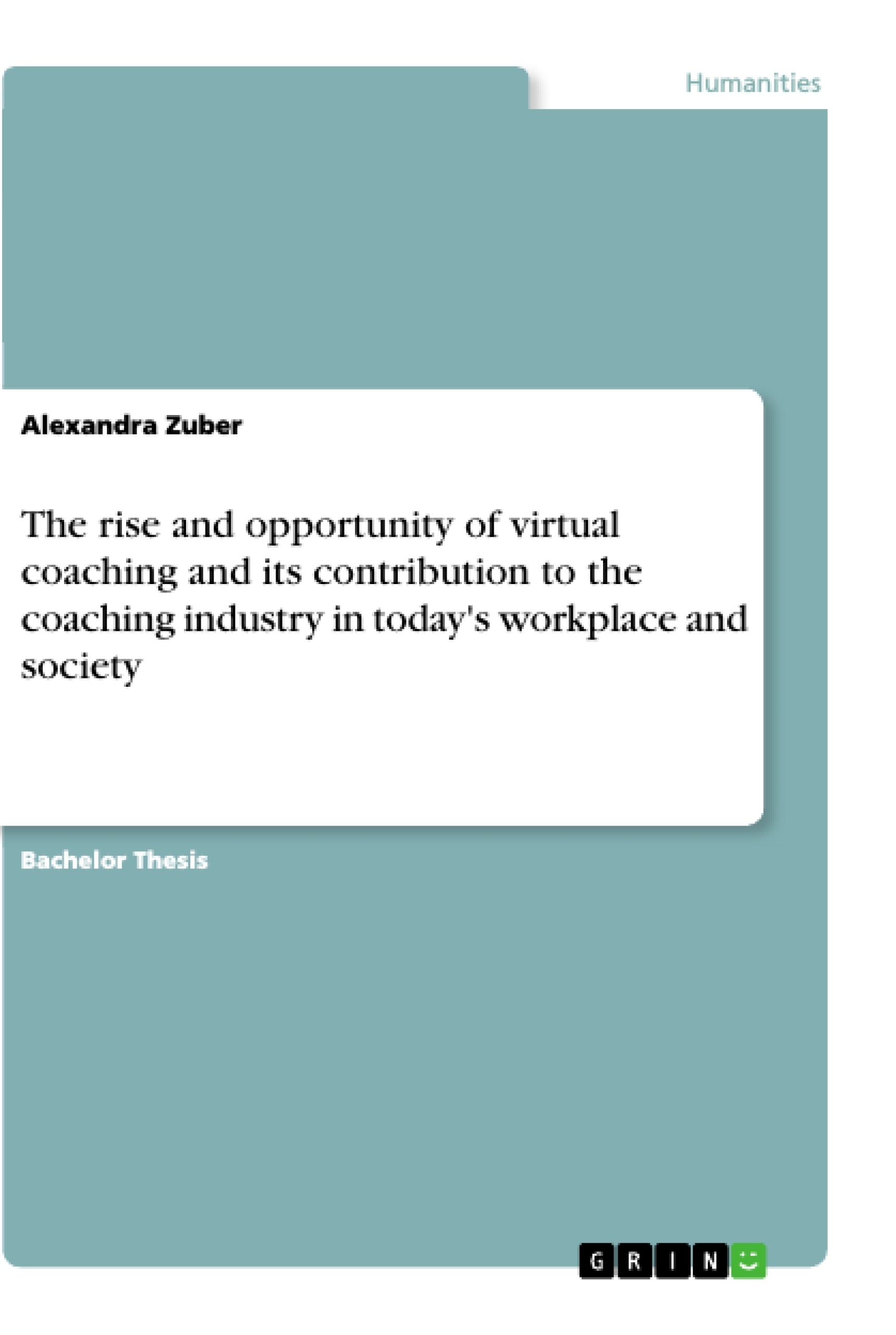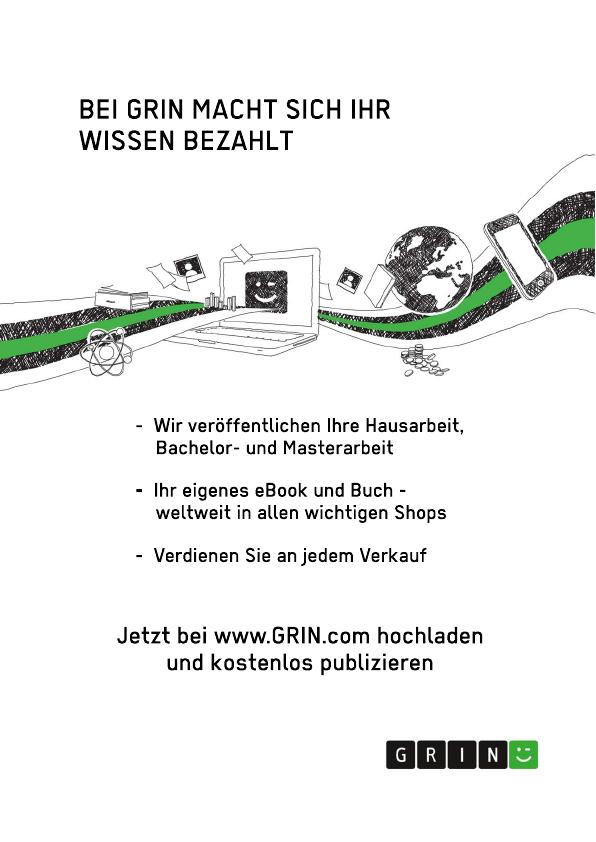This Bachelor Thesis presents a summary of empirical findings of the opportunities of virtual coaching and its areas of application. Thereby it outlines its contribution to the coaching industry in today's workplace and society. Several fields of usage as well as the aspects important to ensure a successful proceeding, requirements from managers regarding this topic as well as changes virtual coaching brings with it in the educational sector, have been analyzed. Data collected in this paper origin from recent research in the North American and Australian literature and business magazines as well as European sources.
Additionally, the research paper contains valuable insights of four experts who are virtual coaches and therefore adds first-hand current information and experience about the topic and its applications. This qualitative data analysis was done according to Mayring. The first research question investigates whether the substitution of traditional coaching with virtual coaching is possible or not. Secondly, it is examined if virtual coaching adds more value to traditional coaching or is more valuable by itself. Whether or not virtual coaching holds a promising future was analyzed in order to answer the third research question.
The findings of the virtual coaching format indicate a promising future as an important part of the coaching process to the coaching industry. They also show that virtual coaching brings huge benefits regarding the cost, time and value efficiency factor. Furthermore, it is a more sustainable and intensive option than traditional coaching. Nevertheless, the complete substitution of traditional coaching should not be reasoned. Virtual coaching brings the world together and offers new opportunities for both coach and coachee in terms of flexibility, freedom, the range of options and instant access to the coaching service, which has not been known to this extent in traditional coaching. This relatively new field is yet to emerge and still requires a lot more research in the future.
Table of Contents
- Chapter 1: Introduction
- Chapter 2: Theoretical Foundations
- Chapter 3: Empirical Study: Virtual Group Coaching (VGC)
- Chapter 4: Discussion and Conclusion
Objectives and Key Themes
This bachelor thesis aims to explore the rise and opportunities of virtual coaching and its contribution to the coaching industry in today's workplace and society. It investigates the effectiveness and potential of virtual coaching methods, comparing them to traditional approaches.
- The increasing importance of virtual coaching in modern workplaces.
- Comparison of virtual coaching methods with traditional coaching approaches.
- The effectiveness and impact of virtual coaching on client outcomes.
- The challenges and opportunities presented by virtual coaching technology.
- The potential of virtual coaching to enhance accessibility and affordability of coaching services.
Chapter Summaries
Chapter 1: Introduction: This chapter introduces the topic of virtual coaching, highlighting its growing relevance in the modern workplace and society. It provides a general overview of the coaching industry and the increasing demand for flexible and accessible coaching services. The chapter sets the stage for the subsequent chapters by outlining the research questions and objectives of the thesis, establishing the context for exploring the potential of virtual coaching as a viable and impactful coaching modality. It also briefly touches upon the methodology to be employed in the subsequent empirical study.
Chapter 2: Theoretical Foundations: This chapter delves into the theoretical underpinnings of coaching, reviewing existing literature and established models relevant to the practice. It provides a comprehensive framework for understanding the core principles and techniques of both traditional and virtual coaching approaches. The chapter analyzes various theoretical perspectives on coaching effectiveness, highlighting key elements such as client-coach relationship, goal setting, and accountability. This theoretical foundation serves as a crucial base for analyzing and interpreting the findings of the empirical study presented in the following chapter. Different coaching models are contrasted and compared to provide a strong theoretical context for later analysis.
Chapter 3: Empirical Study: Virtual Group Coaching (VGC): This chapter presents the results of an empirical study focusing on virtual group coaching (VGC). It details the methodology used, including the study design, participant selection, and data collection methods. The results section provides a thorough analysis of the collected data, examining the effectiveness and impact of VGC on client outcomes. Key findings might include perceptions of the effectiveness of VGC, client satisfaction, and potential limitations. The chapter meticulously presents quantitative and potentially qualitative data to comprehensively evaluate the strengths and weaknesses of VGC in the context of the theoretical framework established in chapter two. Statistical significance (if applicable) and limitations are explicitly addressed.
Keywords
Virtual coaching, online coaching, e-coaching, coaching effectiveness, virtual group coaching, technology-mediated coaching, accessibility, affordability, workplace coaching, coaching industry, empirical study.
Frequently Asked Questions: A Comprehensive Language Preview
What is the purpose of this document?
This document provides a comprehensive preview of a language learning resource, including its table of contents, objectives, key themes, chapter summaries, and keywords. It serves as an overview for potential users, allowing them to understand the scope and content of the complete work.
What topics are covered in this resource?
The resource focuses on virtual coaching, exploring its rise, opportunities, effectiveness, and comparison to traditional coaching methods. Key themes include the increasing importance of virtual coaching in modern workplaces, comparison of virtual and traditional approaches, the impact of virtual coaching on client outcomes, challenges and opportunities presented by virtual coaching technology, and the potential of virtual coaching to enhance accessibility and affordability.
What is the structure of the resource?
The resource is structured into four chapters: Chapter 1 (Introduction), Chapter 2 (Theoretical Foundations), Chapter 3 (Empirical Study: Virtual Group Coaching (VGC)), and Chapter 4 (Discussion and Conclusion). The preview provides summaries for each chapter.
What are the key objectives of the resource?
The main objective is to explore the rise and opportunities of virtual coaching and its contribution to the coaching industry. It aims to investigate the effectiveness and potential of virtual coaching methods compared to traditional approaches.
What methodology is used in the resource?
The resource incorporates a theoretical review of existing literature and established models related to coaching. It also includes an empirical study focusing on virtual group coaching (VGC), detailing its methodology (study design, participant selection, data collection), results analysis, and key findings.
What are the key findings of the empirical study?
The preview does not provide specific findings from the empirical study, only mentioning that it examines the effectiveness and impact of VGC on client outcomes, including perceptions of effectiveness, client satisfaction, and potential limitations. Quantitative and qualitative data are analyzed to comprehensively evaluate the strengths and weaknesses of VGC.
What are the key words associated with this resource?
Keywords include: Virtual coaching, online coaching, e-coaching, coaching effectiveness, virtual group coaching, technology-mediated coaching, accessibility, affordability, workplace coaching, coaching industry, empirical study.
What is the target audience for this resource?
While not explicitly stated, the target audience is likely individuals interested in virtual coaching, including researchers, practitioners, and students studying coaching methodologies and the application of technology in coaching.
- Citation du texte
- Alexandra Zuber (Auteur), 2015, The rise and opportunity of virtual coaching and its contribution to the coaching industry in today's workplace and society, Munich, GRIN Verlag, https://www.grin.com/document/454863




